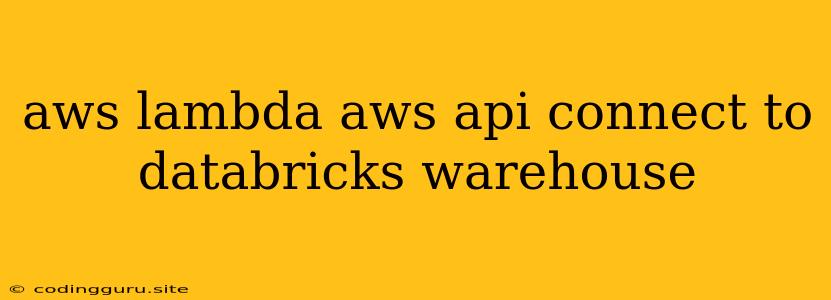Connecting AWS Lambda to Databricks Warehouse for Seamless Data Processing
In the world of cloud computing, efficiency and scalability are paramount. When it comes to data processing, the combination of AWS Lambda and Databricks warehouse offers a powerful and cost-effective solution. This article will guide you through the process of connecting AWS Lambda to your Databricks warehouse, enabling you to leverage the capabilities of both services for seamless data processing.
Why Connect AWS Lambda to Databricks Warehouse?
AWS Lambda, a serverless computing platform, allows you to execute code without managing servers. This makes it ideal for tasks that need to be triggered by events or run periodically. On the other hand, Databricks warehouse provides a powerful and scalable platform for data storage and analysis.
By connecting AWS Lambda to Databricks warehouse, you gain several advantages:
- Simplified Data Pipelines: You can automate data ingestion, transformation, and analysis tasks within a single workflow.
- Cost Optimization: AWS Lambda scales automatically based on demand, ensuring you pay only for the resources used.
- Enhanced Flexibility: AWS Lambda enables you to easily integrate with other AWS services and external systems.
Connecting AWS Lambda to Databricks Warehouse: A Step-by-Step Guide
Here's a step-by-step guide to connecting your AWS Lambda function to your Databricks warehouse:
1. Setting Up Your Databricks Environment:
- Create a Databricks Cluster: Start by creating a Databricks cluster with the necessary resources and libraries for your data processing tasks.
- Configure Database Access: Set up a database in your Databricks warehouse to store and access the data you'll be processing.
- Define Data Schema: Define the structure and data types for your tables within the database.
2. Creating Your AWS Lambda Function:
- Choose the Programming Language: Select a programming language that is compatible with AWS Lambda. Python and Node.js are popular choices.
- Install the Databricks Client Library: Use the Databricks Python client library to connect to your Databricks warehouse from your AWS Lambda function.
- Write the Lambda Code: Implement the logic for your data processing task, including data retrieval, transformation, and loading into your Databricks warehouse.
3. Configuring the AWS Lambda Function:
- Define the Lambda Function Trigger: Select the event that will trigger your AWS Lambda function. For example, it could be an S3 bucket event or a scheduled invocation.
- Set Environment Variables: Provide your Databricks warehouse connection details as environment variables within your AWS Lambda function.
4. Testing and Deployment:
- Test Your Lambda Function: Execute your AWS Lambda function to test the connection and data processing logic.
- Deploy the Lambda Function: Once everything is working correctly, deploy your AWS Lambda function to make it accessible.
Code Example: Connecting AWS Lambda to Databricks Warehouse (Python)
import databricks.sql
def lambda_handler(event, context):
# Establish Databricks Connection
client = databricks.sql.connect(
host=os.environ['DATABRICKS_HOST'],
http_path=os.environ['DATABRICKS_HTTP_PATH'],
token=os.environ['DATABRICKS_TOKEN'],
)
# Execute Data Processing Logic
cursor = client.cursor()
cursor.execute("SELECT * FROM my_database.my_table")
results = cursor.fetchall()
# Process the data as needed
# ...
return {
'statusCode': 200,
'body': 'Data processing complete!'
}
Security Considerations
When connecting AWS Lambda to your Databricks warehouse, security is crucial. Implement the following measures:
- Use IAM Roles: Grant your AWS Lambda function limited access to your Databricks warehouse using AWS Identity and Access Management (IAM).
- Secure Connection: Establish a secure connection between AWS Lambda and Databricks warehouse using HTTPS.
- Data Encryption: Encrypt sensitive data at rest and in transit.
Conclusion
Connecting AWS Lambda to your Databricks warehouse offers a powerful and flexible solution for data processing tasks. By following the steps outlined above, you can efficiently leverage the capabilities of both services to automate data pipelines, optimize costs, and enhance the scalability of your data applications. Remember to prioritize security when configuring your connection and implementing data processing logic.
